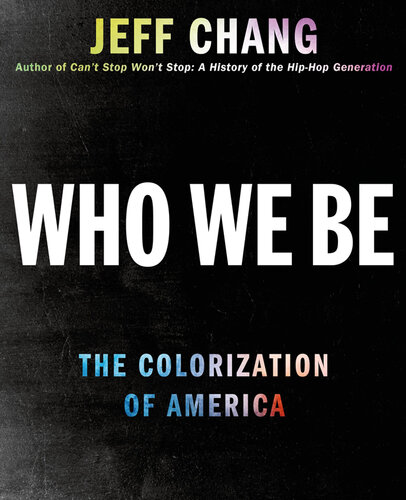
Who We Be
A Cultural History of Race in Post-Civil Rights America
کتاب های مرتبط
- اطلاعات
- نقد و بررسی
- دیدگاه کاربران
نقد و بررسی

September 15, 2014
Sprawling examination of how American society has responded to multiculturalism and demographic diversity. Chang (Can't Stop Won't Stop: A History of the Hip Hop Generation, 2005), the executive director of the Institute for Diversity in the Arts at Stanford, focuses on visual artists and political dreamers in narrating how once-marginalized communities responded to the civil rights movement and then to the white backlash promoted by Richard Nixon and Republican strategist Lee Atwater. Amid violence and generational strife, cultural happenings, such as the Black Arts movement of the late 1960s, and innovators like African-American cartoonist Morrie Turner fomented "a grand yearning, a mass becoming, an end to the monoculture, the true arrival of a post-segregated nation." Corporations quickly co-opted this outsider aesthetic, a process famously embodied in the early '70s by Coca-Cola. Chang discusses important yet forgotten nodes in the developing dichotomy of multiculturalism versus "culture war," as when conservatives began attacking the National Endowment for the Arts during the '80s: "Defunding public culture proved good Republican politics." Yet simultaneously, Jesse Jackson "incepted into the mainstream the prophetic images of the rainbow" in his attempts to make the Democratic Party more inclusive. The triumph of "political correctness" seemed evident in the fierce controversies over the Whitney Biennials of the '90s, while Benetton's successful "Colors" ad campaign and magazine showed that "capitalism had at long last embraced its future in identity and diversity." As the Clinton years approached their end, "everything and nothing was multicultural," contrasting with the triumphalism and xenophobia that followed 9/11. Chang ends with a jaundiced portrait of the "hope" accompanying Barack Obama's presidency, smothered by conservative resentment and a massive economic crisis. The author adeptly synthesizes other scholars' research and has an eye for precise details, though he also relies on a labored fusion of academic sociology and urban buzzwords-e.g., "In this era of fragmentation and unrest, it was time for [Coca-Cola]...to reassert some alpha swag." An intriguing attempt at cutting through the dissonance of a series of changing cultural milieus.
COPYRIGHT(2014) Kirkus Reviews, ALL RIGHTS RESERVED.

October 1, 2014
By 2042, there will be no majority race in the U.S. What will that mean? Cultural analyst Chang (Can't Stop Won't Stop: A History of the Hip-Hop Generation, 2005) looks back on the complicated history of race in the U.S. and ahead at the demographic promise of a much more racially diverse nation. Chang notes that the nation has been colorizing for centuries, from slavery through desegregation and an uneasy, halfhearted integration. Drawing on media images and interviews, Chang chronicles ideas of race since the mid-1960s. He features cartoonists from Morrie Turner (Wee Pals) to Aaron McGruder (The Boondocks) and their personal journeys as they navigated a profession with few blacks and reflected on changing images of race. He also explores the branding of multiculturalism seen in ads for brands including Coca-Cola and Benetton. His larger focus is on how art, music, and commerce have reflected changes in attitudes and images of race, from minstrelsy to militancy to multiculturalism. In this engaging look at race and culture, Chang raises questions but admits there are no simple or easy answers as culture continues to evolve.(Reprinted with permission of Booklist, copyright 2014, American Library Association.)

August 1, 2014
Beginning with the 1960s and continuing until the fatal shooting of the African American teenager Trayvon Martin, this book examines advertising, comics, media, and fine arts as they relate to the politics of multiculturalism in America. Chang (executive director, Inst. for Diversity in the Arts, Stanford Univ.; Can't Stop Won't Stop) states that he does not mean to write the definitive work on the subject of multiculturalism, preferring to emphasize lesser-known artists and movements. Because the subject of the book is nebulous, the chapters can feel disconnected. One section discusses conservative political strategies while the next includes a biography of an obscure poet. However, engaging and fast-paced writing makes the volume worth reading, and the inclusion of Native American, Asian American, and Latino artists strengthens the theme. For a reader interested in the history of identity art, this work can bring up new names to research. VERDICT Recommended for those interested in race relations in America, as well as readers seeking background information on the author's previous works.--Jessica Spears, Monroe Coll. Lib., Bronx, NY
Copyright 2014 Library Journal, LLC Used with permission.

May 1, 2014
Chang won our attention with Can't Stop Won't Stop: A History of the Hip-Hop Generation, a multiaward winner that's now a standard text at hundreds of institutions nationwide. Here he moves from the March on Washington to the killing of Trayvon Martin and beyond to examine how our views on race have--and haven't changed--in 50 years.
Copyright 2014 Library Journal, LLC Used with permission.

























دیدگاه کاربران